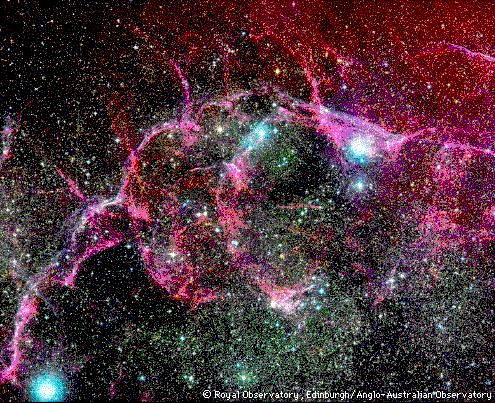Credit & Copyright:
Anglo-Australian Telescope Board
Explanation:
About 11,000 years ago a star in the constellation of
Vela exploded.
This bright
supernova
may have been visible to the
first human farmers. Today the
Vela supernova
remnant marks the position of a relatively close and
recent explosion in
our Galaxy.
A roughly
spherical, expanding shock wave
is visible in X-rays. In the
above optical photograph, the upper left
corner of the spherical blast wave is shown in detail. As
gas flies away from the detonated star, it reacts with the
interstellar medium, knocking away closely held
electrons from even
heavy elements. When the
electrons recombine with these atoms, light in
many different colors and
energy bands is produced.
1999 2000 2001 2002 2003 2004 2005 2006 2007 2008 2009 2010 2011 2012 2013 2014 2015 2016 2017 2018 2019 2020 2021 2022 2023 2024 2025 |
Yanvar' Fevral' Mart Aprel' Mai Iyun' Iyul' Avgust Sentyabr' Oktyabr' Noyabr' Dekabr' |
NASA Web Site Statements, Warnings, and Disclaimers
NASA Official: Jay Norris. Specific rights apply.
A service of: LHEA at NASA / GSFC
& Michigan Tech. U.
|
Publikacii s klyuchevymi slovami:
Vela - supernova remnant - ostatok Sverhnovoi - opticheskii diapazon - Sverhnovye
Publikacii so slovami: Vela - supernova remnant - ostatok Sverhnovoi - opticheskii diapazon - Sverhnovye | |
Sm. takzhe:
Vse publikacii na tu zhe temu >> | |
